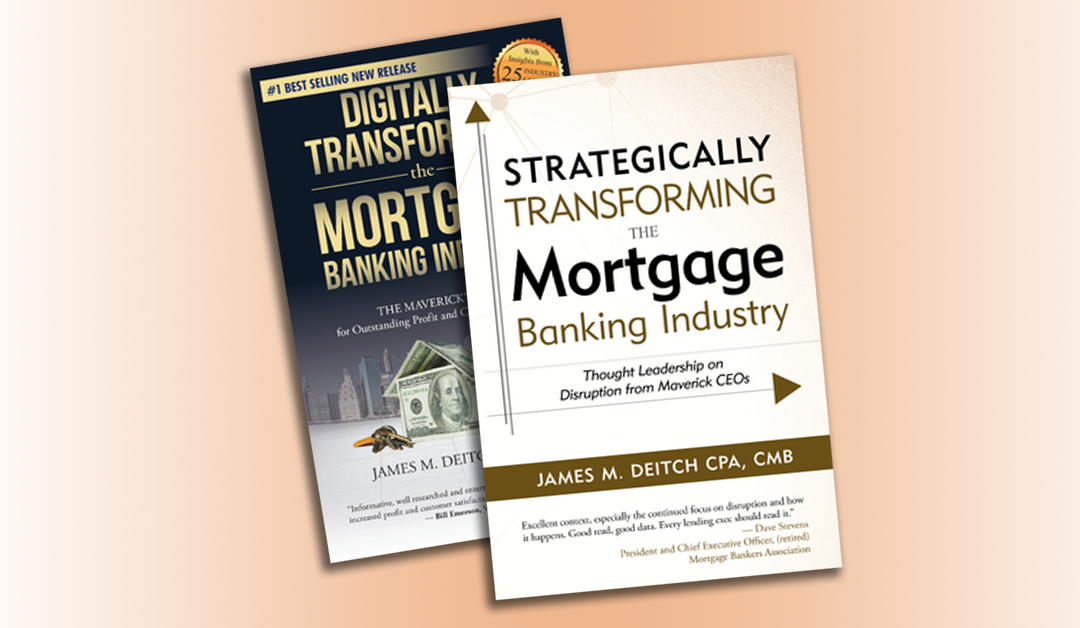Forward
by Alex Henderson
Jim Deitch’s first book on mortgage banking transformation, Digitally Transforming the Mortgage Banking Industry, — an instant bestseller — was conceived by Jim at the 2017 MBA Chairman’s Conference. The industry was experiencing higher costs to produce and profit was under pressure. The average earnings of Independent Mortgage Bankers were released the second day of the Conference – 11 basis points on loan production, well below the long-term average of about 50 basis points.
Jim served on a panel headed by Bill Emerson of Quicken which focused on the cost to produce and turnaround time. The idea at the Conference was that better deployment of technology would transform the mortgage banking business. Jim came up with a brilliant idea for a book — what if he interviewed highly successful transformative mortgage industry CEOs to find out what worked in the real world. Would they be willing to be quizzed on their secrets by someone who knew what questions to ask?
Digitally Transforming the Mortgage Banking Industry was born. Amazingly Fifty CEOs agreed to be interviewed by Jim. Twenty-Five CEOs Jim found to be “mavericks” willingly shared their thinking and secrets of success with Jim. As noted by a number of reviewers, the book contained “great insights from some of the best known names in the industry” with “an amazing roster of Mortgage banking heavy hitters interviewed for their opinions on where the industry needs to go to stay productive and competitive.”
Digitally Transforming was an best-seller – the #1 new release on Amazon in its category. Although several reviewers found that the book was “a remarkably compelling look” at “behind the scene insights from leaders within the industry” reviewers also stressed Jim’s own “incisive thinking” in developing the book’s themes. As one reviewer noted “None of the many Mavericks who’ve generously shared their thinking own the whole story; it took someone to put them together for a clear picture to emerge.”
The year after the 2017 conference was very turbulent. The 2018 MBA Chairman’s Conference focused on disruption of the industry by a variety of forces including low housing inventory, shifting consumer expectations, and another profit tremor announced at the conference: 60% of Independent Mortgage Bankers lost money and the average earnings of IMBs in the most recent reported quarter was a loss of 9 basis points on loan production.
Averages are deceiving and some IMBs and lenders are achieving excellent profit performance, but most are not. The reader of this book will hear from executives that deployed the approach described in Digitally Transforming and found considerable success. However, in this follow-up book Jim takes his incisive thinking and business acumen to a new level. The reasons for the widely varied performance are manifold, as discussed in this book. Those many reasons led to this follow-up book with a new title: Strategically Transforming the Mortgage Banking Industry.
Technology is of course a key lever of industry transformation, but the economic landscape has changed tremendously since the 2017 MBA Chairman’s conference and requires mortgage bankers to consider additional strategic levers. Tight housing inventories, rapid home appreciation, rapid evolution of big data, changing consumer preferences and expectations, and a regulatory environment more cognizant of the damages from regulatory excess have emerged. The private label securities market and QM safe harbor for banks under $10 billion in assets will have major industry impact.
The tone at the 2018 Chairman’s Conference was decidedly different than 2017. Transformation was still top of mind, but the focus had expanded: Strategic Transformation, not just Technological Transformation, which is why Jim decided to write a second book, Strategically Transforming. To address the timely nature of strategic transformation, Jim decided to release this book 120 days from the 2018 Chairman’s Conference. That’s a very fast timeline to conceive, research, and write a follow-up book. But speed to address this important issue is critical.
The need for speed is becoming a defining factor in the shape of our industry, as is clear from Jim’s discussions with the mavericks in this book. Many of the mavericks interviewed in the first book are revisited for their strategic insight. New mavericks have been identified.



